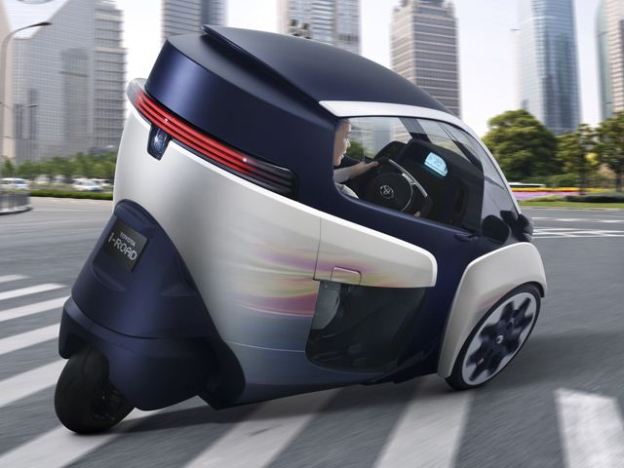 The Toyota i-Road Concept – set to make its world debut at the 2013 Geneva Motor Show this week – puts a completely different spin on the idea of three-wheeling.
The Toyota i-Road Concept – set to make its world debut at the 2013 Geneva Motor Show this week – puts a completely different spin on the idea of three-wheeling.
The all-electric vehicle, the latest in a wave of Personal Mobility Devices (PMD) concepts being explored by carmakers, gets 31 miles per charge. But the real beauty of this wild looking ride is the vehicle’s technology system “Active Learn,” which automatically balances the vehicle when cornering or travelling over rough surfaces.
Engineered so that practically anyone can drive the i-Road, “Active Lean” uses a lean actuator and gearing mounted above the front suspension member, linked via a yoke to the left and right front wheels for drive stability.
A computer calculates the required degree of lean based on steering angle, gyro-sensor and vehicle speed information, with the system automatically moving the wheels up and down in opposite directions, applying lean angle to counteract the forces of cornering.

The i-Road’s cockpit features tandem seating, which makes it easy to weave in and out of traffic and ideal for squeezing in tight parking spots. And the entire thing measures only 2.35 meters long, 850mm wide and 1.4 meters tall. As you can imagine, it’s incredibly lightweight, weighing in at about 660 lbs.
Power is provided by a lithium-ion battery paired to two 2-kilowatt (2.7-horsepower) electric motors driving the front wheels. According to Toyota, charging the iRoad should take about 3 hours using an ordinary 120 volt household power outlet.
The i-Road Concept only has a top speed of 28 mph. But with the kind of traffic congestion being predicted for the future in urban areas, speed really isn’t a factor with a vehicle like this. The appeal of anything with wheels in urban areas is quickly becoming more about the efficiency of getting from point A to point B rather than how fast you can zip through the city.
Editors' Recommendations
- Toyota gives its sweet, race-ready Supra the green flag for production
- Toyota’s LQ concept has A.I. tech that knows when you’re stressed


